How to track underground water pipe?

If you plan to dig in your yard, you’ll need to know the location of water pipes or any other utility lines because doing this type of work without it will increase your risk of damage. This can cause your yard or even your entire home to flood, which can cost a lot of money to repair. Most water pipes are made of PVC or some other similar material, so a
utility locator with a metal detector isn’t going to work. Finding a PVC pipe isn’t easy. And because it requires the use of a special process, not every underground
utility locator will do the job.
Steps for Underground Water Pipe Location
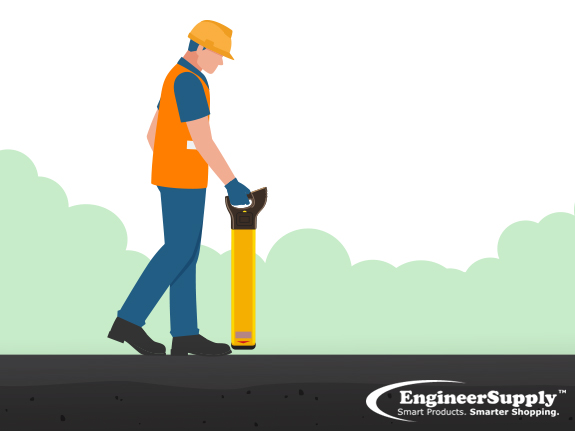
To find an underground water pipe, you’ll need to use a
utility line locator that can find both metal and plastic pipes. Depending on the area in which you’re currently working, these lines could be made of either material. So if you want to get the most accurate results, you’ll need a tool that can find both. From there, you can follow the following steps:
- Set up the utility locator as directed — This will depend on which model you’re currently using. Some locators will make a noise (usually through the use of headphones) when a pipe has been found, while others will indicate it on a built-in display.
- Aim the underground utility locator at the ground as you walk — The device will tell you either visually or audibly if you’re standing above an underground pipe. Mark each location according to your preference.
This is the basic process for finding underground water lines, but a
utility locator can use any of the following methods to look for these subsurface structures:
- Acoustic Method — This method has been around for hundreds of years. It involves the use of branches or rods that are held over the ground, as they look for a subsurface location based on their movements. Some people question the accuracy of this process, while others swear by it.
- Ground Penetrating Radar (GPR) — This method can be effective for finding underground water pipes, because it can locate both metallic and non-metallic objects. But because you have to remove the hydrant’s cap, place a leak detection device the right way, and pressurize the hydrant, it requires a little more effort.
- Electromagnetic Conductivity (EM) — This is a more specialized way of finding underground utility lines, and it’s more expensive. While it can find wires or underground electric lines, it can’t find underground PVC pipes. But it can find metallic pipes if you know how use it properly.
- Ultra-High Radio Frequencies — This method works well in wet soil, snow, clay, or standing water because it can penetrate surfaces that might inhibit some of the other methods. A hand-held device is swept over the ground, while the user reads different indicators on the unit.


If you’re looking for a quality
utility locator that you can use to find underground water pipes, feel free to look at what we have at
Engineering Supply. We’re sure you’ll be able to find a tool that will meet your specific needs.
Best Pipe Locators
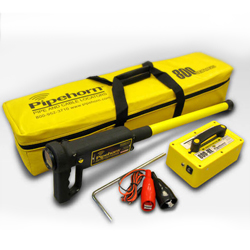
This dual-frequency underground utility locator is always recommended over Pipehorn’s single-frequency model. Because it has the 9kHz frequency that’s needed to find utility lines buried deeper underground, it has the range you need to find a number of underground pipes and cables. With its superior high-frequency performance, it's one of the best utility location tools in the industry when direct connect isn’t possible. And for the toughest conductors (such as coated iron pipes with insulated joints or street and parking lot lights), nothing else will sweep an area for unmarked utility lines than this utility locator.
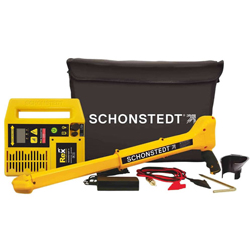
This multi-frequency pipe locator by Schonstedt is a great choice for the working professional, because it has the following features:
- The transmitter is less than 2 inches thick and weighs less than 4 pounds.
- The entire unit fits easily into a custom storage bag.
- The receiver and transmitter together weigh under 7 pounds for an ultralight design.
- The receiver can retract for easier carrying.
- Capable of 512 Hz, 33 kHz, and 82 kHz frequency detection.
- Capable of 50/60 Hz passive and 512 Hz sonde detection.
- The transmitter comes with rechargeable batteries.
This unit is built for utility professionals in the water, sewer, gas, electric, and telecommunication industries.
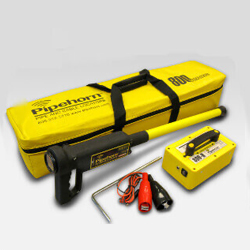
With the ability to detect frequencies of up to 480 kHz, this pipe locator can find utility lines that are buried down to 18 feet deep (depending on the type of connection, the condition of the soil, and how well it can conduct the signal). It also has a fast-response signal strength and a sharp audio tone that allows for precision pinpointing. And with a watertight reinforced receiver wand, it's incredibly durable. The transmitter has a high-impact ABS housing that’s bright yellow, so it’s easier to see.
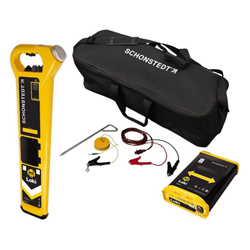
This utility locator is perfect for “sweeping” a large area to find buried assets quickly and easily. The Schonstedt Loki has a number of features that support the quick and easy detection of underground utility lines. Some of them include but may not be limited to:
- The 512 Hz frequency can be used to trace metallic pipes, while the 82 kHz frequency can find hard-to-locate jointed pipes.
- The simple mode selection matches the device to the signal type you need to locate.
- The Sonde Mode can find a signal being transmitted by a compatible sonde.
- The Transmitter Mode can find transmitter signals being imposed on buried utilities.
- The Power Mode can find the electromagnetic fields being generated by loaded power cables.
- The Dual Mode simultaneously searches for and identifies transmitter and power signals for quicker sweeps.
- The ShallowAlert feature will warn you of the possible presence of shallow cables and utility lines in every mode.
- The NoiseProtect feature allows you to use the device in areas that are electrically noisy.
Be sure to pick yours up at Engineer Supply today!
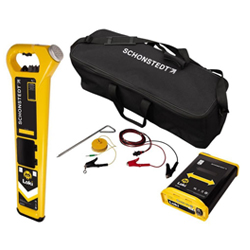
With a receiver that weighs 4.9 pounds and a transmitter that weighs 4.0 pounds, this unit is a lightweight tool that’s perfect for finding pipes, cables, and underground utility lines in large areas. It also has a IP54 rating, which makes it resistant to water and dust. The transmitter has a built-in speaker that generates an audio signal, which can be heard over road traffic. The receiver also has a detachable speaker that can double as an earpiece.
If you’re looking for an underground utility locator to help you find buried pipes and cables, be sure to look at what we have at Engineer Supply.
Please Wait...
